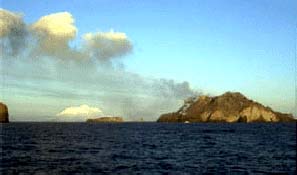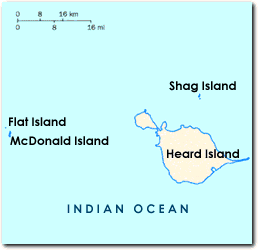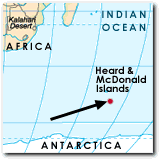Heard Island and McDonald Islands

Fire and ice
|
|
 Smoke rises from McDonald Island's volcano.   |
Where Are They?
For a remote, icy spot, skip the crowds on Antarcticaâwhich was visited by an estimated 10,800 people in the 1997â1998 tourist seasonâand head for Heard. Who has ever heard of Heard? Thankfully, almost no one.
The Australian territories of Heard and McDonald Islands are 2,500 miles southwest of Perth, Australia, in the southern Indian Ocean. The next stop south is the Amery Ice Shelf. Heard, a sizable ice-covered hunk 27 miles long and 3 miles wide, and the McDonald Islandsâa pair of rocky specks 25 miles due westâmake up what are considered by the American Association for the Advancement of Science to be among "the wildest places on earth."
What to Expect
Described as "bleak and mountainous," with frigid temperatures and unpredictable gales, these islands are for romantics of the rugged sort, enamoured of Antarctica and polar exploration. Heard is the only place in the world where all six species of Antarctic seal are found, and the McDonald Islands (made up of McDonald and Flat islands) are a haven for penguins, seals, and birds. Heard was first discovered in 1833 by a British sealing vessel, and was named after an American merchant sea captain, John A. J. Heard.
Highlights
If the names Shackleton and Amundsen arouses the glacier milk that courses through your veins, then you'll love Heard Island. The Australian polar explorer John Bechervaise got his start there, living for a year on Heard with 12 others in 1953, while conducting meteorological and biological observations. Later the explorer was honored with his own Antarctic islandâBechervaise Island, which lies near the Antarctic coast. But if you're looking for extreme isolation where nothing will remind you of humanity, nothing beats the McDonalds . . . absolutely no one has ever lived on them. It'll be just you, a few glaciers, and the penguins.
Another major attraction of the islands are the volcanoes. Heard has an active stratovolcano named Big Ben (9,000 ft) that has erupted at least eight times since 1910. Although many of the eruptions are subglacialâand make for paltry fireworksâthree have produced lava flows. The last eruption was in 1993.
On McDonald Island, a volcano erupted in December 1996, after having lain dormant for the previous 35,000 years. Vulcanologists have described it as "the first active volcano that has been discovered in the Southern Hemisphere for over 50 years." They also warn that it "could erupt again at any time, and could be very dangerous for anyone on the island."
For mountaineers, Heard Island offers the challenge of climbing Big Ben. Explorer John Bechervaise failed quite dramatically. First, he and his two companions were completely buried by a sudden blizzard. Then, after they managed to dig themselves out, Bechervaise's two companions fell into a crevasse. Fortunately, other members of the expedition rescued them (there are some advantages to traveling in numbers).
There's only a slim chance that your privacy may be compromised on the islands. Do watch out for the occasional scientist. More worrisome are the poachers, who sometimes prowl the surrounding icy waters in pursuit of the obscure "Patagonian toothfish" (so rare it wasn't even named until five years ago). The Australians have decided to get tough with the poachers and have occasionally sent out their navy to take care of matters. Should you happen to be in the neighborhood the next time Australian gunboats decide to teach them a lesson, you can kiss your Antarctic asylum goodbye.
Navassa Island |
Introduction |
Howland Island |







